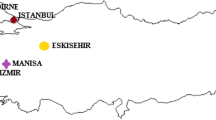Abstract
Stachybotrys chartarum is an indoor mold that has been associated with pulmonary hemorrhage cases in the Cleveland, Ohio, area. This study applied two new quantitative measurements to air samples from a home in which an infant developed PH. Quantitative polymerase chain reaction and a protein synthesis inhibition assay were used to determine the level ofS. chartarum spores and their toxicity in air samples taken before, during, and after a remediation program was implemented to remove the fungus. Initial spore concentrations were between 0.1 and 9.3 spores/m3 of air, and the toxicity of air particulates was correspondingly low. However, the dust in the house contained between 0.4 and 2.1×103 spores/mg (as determined by hemocytometer counts). The remediation program removed all contaminated wallboard, paneling, and carpeting in the water-damaged areas of the home. In addition, a sodium hypochlorite solution was used to spray all surfaces during remediation. Although spore counts and toxicity were high during remediation, air samples taken postremediation showed no detectable levels ofS. chartarum or related toxicity. Nine isolates ofS. chartarum obtained from the home were analyzed for spore toxicity, hemolytic activity, and random amplified polymorphic DNA banding patterns. None of the isolates produced highly toxic spores (>90 μg T2 toxin equivalents per gram wet weight spores) after growth for 10 and 30 days on wet wallboard, but three isolates were hemolytic consistently. DNA banding patterns suggested that at least one of these isolates was related to isolates from homes of infants with previously investigated cases.
Similar content being viewed by others
References
Levy J, Wilmott R. Pulmonary hemosiderosis. In: Hilman BC, editor.Pediatric Respiratory Disease: Diagnosis and Treatment. Philadelphia, PA: W. B. Saunders; 1993:543–549.
Centers for Disease Control and Prevention. Acute pulmonary hemorrhaging/hemosiderosis among infants: Cleveland, January 1993–November 1994.MMWR Morb Mortal Wkly Rep. 1994; 43:881–883.
Etzel RA, Montana E, Sorenson WG, Kullman GJ, Miller JD. Pulmonary hemosiderosis associated with exposure toStachybotrys atra. Epidemiology. 1996:S38.
Etzel RA, Montana E, Sorenson WG, Kullman GJ, Allan TM, Dearborn DG. Acute pulmonary hemorrhage in infants associated with exposure toStachybotrys atra and other fungi.Arch Pediatr Adolesc Med. 1998;152:757–762.
Montana E, Etzel RA, Dearborn DG, Sorenson WG, Hill R. Acute pulmonary hemorrhage in infancy associated withStachybotrys atra, Cleveland, Ohio, 1993–1995.Am J Epidemiol. 1995;141:S83.
Flannigan B, Miller JD. Health implications of fungi in indoor environments: an overview. In: Samson RA, Flannigan B, Flannigan ME, Verhoeff AP, Adan OCG, Hoekstra ES, eds.Health Implications of Fungi in Indoor Environments. Amsterdam, The Netherlands: Elsevier Science Publications; 1994:3–28.
Croft WA, Jarvis BB, Yatawara CS. Airborne outbreak of trichothecene toxicosis.Atmosph Environ. 1986;20:549–552.
Cooley JD, Wong WC, Jumper CA, Straus DC. Correlation between the prevalence of certain fungi and sick building syndrome.Occup Environ Med. 1998;55:579–584.
Johanning E, Morey PR, Jarvis BB. Clinical-epidemiological investigation of health effects caused byStachybotrys atra building contamination.Indoor Air. 1993;1:225–230.
Johanning E, Biagini R, Hull D, Morey P, Jarvis BB, Landsbergis P. Health and immunology study following exposure to toxigenic fungi (Stachybotrys chartarum) in waterdamaged office environment.Int Arch Occup Environ Health. 1996;68:207–218.
Vesper SJ, Dearborn DG, Yike IG, Sorenson WG, Haugland RA. Hemolysis, toxicity and RAPD analysis ofStachybotrys chartarum strains from the Cleveland pulmonary hemorrhage outbreak and non-Cleveland strains.Appl Environ Microbiol. 1999;65:3175–3181.
Dearborn D. Pulmonary hemorrhage in infants and children.Curr Opin Pediatr. 1997; 9:219–224.
Dearborn DG, Yike I, Sorenson WG, Miller MJ, Etzel RA. Overview of the investigations into pulmonary hemorrhage among infants in Cleveland, Ohio.Environ Health Perspect. 1999;107(suppl):495–499.
Haugland RA, Vesper SJ, Wymer LJ. Quantitative measurement ofStachybotrys chartarum conidia using real time detection of PCR products with the TaqManTM Fluorogenic probe system.Molec Cell Probes. 1999;13:329–340.
Yike I, Allan T, Sorenson WG, Dearborn DG. Highly sensitive protein translation assay for trichothecene toxicity in airborne particulates: comparison with toxicity assay.Appl Environ Microbiol. 1999;65:88–94.
New York City Health Department.Guidelines on Assessment and Remediation of Stachybotrys atrain Indoor Environments. Proceedings of the International Conference, Saratoga Springs, New York, October 7–October 9, 1993. New York: Eastern New York Occupational Health Program.
Jarvis BB. Macrocyclic trichothecenes from BrazilianBaccharis species: from microanalysis to large scale isolation.Phytochem Anal. 1992;3:241–249.
Haugland RA, Heckman JL, Wymer LJ. Evaluation of different methods for the extraction of DNA from fungal conidia by quantitative competitive PCR.J Microbiol Methods. 1999;37:165–176.
Fujimori F, Okuda T. Application of the random amplified polymorphic DNA using the polymerase chain reaction for efficient elimination of duplicate isolates in microbial screening. I. Fungi.J Antibiotics. 1994;47:173–182.
Hinkley SF, Jiang J, Mazzola EP, Jarvis BB. Atranones: novel diterpenoids from the toxigenic moldStachybotrys atra.Tetrahedron Lett. 1999;40:2725–2728.
Jarvis BB, Sorenson WG, Hintikka E-L et al. Study of toxin production by isolates ofStachybotrys atra andMemnoniella echinata isolated during a study of pulmonary hemosiderosis in infants.Appl Environ Microbiol. 1998;64:3620–3625.
Jarvis BB, Salemme J, Morais A.Stachybotrys toxins. 1.Natural Toxins. 1995;3: 10–16.
Author information
Authors and Affiliations
Corresponding author
Rights and permissions
About this article
Cite this article
Vesper, S., Dearborn, D.G., Yike, I. et al. Evaluation ofStachybotrys chartarum in the house of an infant with pulmonary hemorrhage: Quantitative assessment before, during, and after remediation. J Urban Health 77, 68–85 (2000). https://doi.org/10.1007/BF02350963
Issue Date:
DOI: https://doi.org/10.1007/BF02350963




